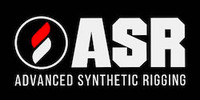Synthetic Line Inspection Criterion
Not all abrasion is harmful to synthetic line. In fact it is normal for a synthetic rope to lose some of its diameter due to fiber abrasion, and when small surface fibers are exposed to wear, they will start to break and create a fuzzy texture known as “mild abrasion.” This is normal and can even serve to protect the rope from further wear. Although many ASR products are coated with fiberlock, normal wear can eventually expose the rope’s surface, at which point localized mild abrasion is likely. While the development of mild abrasion should be expected, abrasion that doesn’t stabilize after a few uses should be monitored and addressed. Excessive abrasion can be caused by repeated contact with sharp edges or rough surfaces. Inspect for excessive damage by looking closely at the inner and outer fibers. Below is a list of basic inspection criterion that should be considered when reviewing the condition of synthetic lines:
INSPECTION PRIOR TO EACH USE - Inspectors should always act conservatively when making recommendations for further use:
- VISUAL EXAMINATION: Visually examine the entire rope length for detectable damage and deterioration, including at eye splices. Inspect for high or low strands and randomly uneven cross sections. Look for abrasions, cuts, or broken strands.
PERIODIC INSPECTION PROTOCOL - Frequency and conditions of use will determine periodicity of Inspection. Inspectors should always act conservatively when making recommendations for further use:
- VISUAL EXAMINATION: Visually examine the entire rope length for detectable damage and deterioration, including eye splices. Inspect for high or low strands and randomly uneven cross sections. Look for corkscrewing, as well as abrasions, cuts, or broken strands. If the rope has been exposed to chemicals or excessive heat, a visual inspection may reveal discoloration and brittleness of the fibers, melted/bonded fibers, or observed hardening or stickiness.
- TACTILE EXAMINATION: Feel for unevenness, rough spots and stiff (lacking flexibility) sections. Check braided ropes for hardness. Pushing on the rope should cause the braids to open. Braided ropes should be supple and bend easily. They should flatten slightly when compressed laterally.
- INTERNAL INSPECTION: Dirt and grit cause internal fiber abrasion in ropes that are in regular use. Most ropes can be forced open for internal inspection. Turn twisted rope slightly to open the interior for observation. Push on single braided or plaited ropes and/or use a fid to open the interior to view. Melted internal fibers may indicate shock loading or other conditions that merit retirement. Oil and grease deposits, of themselves, do not damage most rope materials, however, they trap dirt and grit and may make the rope difficult or unpleasant to handle.
- ROPE DIAMETER: Measure the rope circumference in a number of places, in particular in any damaged areas. This is most easily done with a thin whipping twine, thin metal or fabric tape measure or a pi-tape, wrapped around the rope with slight hand tension. Make note of nominal circumference, and any point on the rope where the circumference varies more than 10 percent from what is found on most of the rope. Ropes may decrease in circumference if well used and may be less than specified for new ropes. Circumference measurement for 3/8” line is approx 1.18 inches.
- KNOTS: Knots must not be used unless the working load is reduced by an appropriate amount (50% of published rope strength unless specific contrary data is available). It is cause for retirement or downgrading if a knot is not called for and cannot be removed or the rope reveals structural damage due to knotting.
- PROTRUDING STRANDS: Check for Protruding Strands – such strands can be snagged or pulled out from the rope body. As long as the strand isn’t broken, this is repairable - to repair, work the strand back into the rope by carefully tugging on adjacent strands until the excess is distributed evenly. A protruding strand in service could easily snag or break, causing further issues.
CRITERION FOR RETIREMENT:
- Missing or illegible identification tag.
- Excessive wear leading to 10% loss of fiber cross-section in whole rope or in an individual strand cross-section.
- Visible damage; i.e. broken or burned strands, splice slippage, charred, powdered or broken internal strands. Cut outer filaments. Rope is inflexible and cannot be pried open for internal inspection.
- Rope twisted or compressed in such a way that the interior between strands is exposed when rope is at rest.
- Cut damage in eye or splice.
- Kink is present and will not disappear completely when slight tension is applied, or springs back when tension is removed. Rope is hard and flattened at kink.
- Significant discoloration, brittle fibers, fusion, bonding of fibers, hardness due to suspected or known chemical exposure.
- Significant grit or silt deposits on the inside. Broken or powdery fiber material may be present.
- Rope significantly impregnated with oil or sticky substances. This material attracts and retains dirt and grit. It is not possible to clean the rope.
- Fittings that are pitted, corroded, cracked, bent, twisted, distorted, gouged or broken.
- Other conditions, including visual damage, that cause doubt as to the continued use of the sling.
This list of inspection and retirement criterion is by no means complete, and is simply provided to present the kinds of things that should be reviewed as part of a preventative maintenance approach to equipment management. The Cortland Institute has published an excellent International Guideline for this topic: CI 2001-04 Fiber Rope Inspection and Retirement Criteria", which lays out "Guidelines to enhance durability and the safer use of fiber rope". The use of rope and cordage products has inherent safety risks which are subject to highly variable conditions and which may change over time. Compliance with standards and guidelines does not guarantee safe use under all circumstances.
